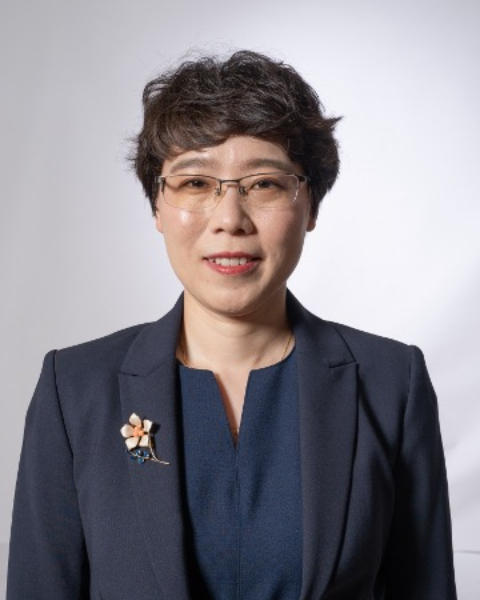QP 04 - H&N 4: Pitching Clinically-focused Research to Improve Outcomes and Prognostication
1019 - Neoadjuvant Chemoimmunotherapy Followed by Surgery and Response-Adapted Adjuvant Radiotherapy for Head and Neck Squamous Cell Carcinoma
Monday, September 30, 2024
5:10 PM - 5:15 PM ET
Location: Room 152

Yuan Wu, MD
Hubei Cancer Hospital
Wuhan, Hubei
Presenter(s)
Y. Qian, and Y. Wu; Hubei Cancer Hospital, Wuhan, China
Purpose/Objective(s): Immunotherapy has been shown to be effective in advanced head and neck squamous cell carcinoma (HNSCC). The administration of immunotherapy in the neoadjuvant setting for locally advanced HNSCC is still under investigation. We aim to evaluate the anti-tumor activity of sintilimab, a PD-1 inhibitor, with chemotherapy prior to surgery in locally advanced HNSCC and explore a de-escalation treatment strategy. Materials/
Methods: This was an open-label, single-arm, phase 2 study. Patients with resectable stage III-IVB HNSCC were enrolled. All participants received sintilimab 200 mg in combination with paclitaxel and cisplatin every 3 weeks for three cycles, followed by surgery and response-adapted adjuvant radiotherapy. The primary endpoint was the major pathologic response (MPR) rate. Patients with a MPR received a de-escalated dose (less than 54Gy/25f) of radiotherapy, and patients with a non-MPR received a full dose (60Gy/30f) of radiotherapy. The trial was conducted using Simons optimal two-stage design. This trial is registered on ClinicalTrials.gov, NCT05476965.
Results: Between May 2021 and June 2023, 30 participants were enrolled at one institution. Twenty-nine patients received three cycles of chemoimmunotherapy. Twenty-eight patients received definitive treatment, including 6 patients with concurrent chemoradiotherapy, and 22 patients underwent surgery. The MPR rate was 59.1% (95% CI 38.7-76.7). Clinical to pathologic downstaging was observed in 16 of 22 participants and the R0 resection rate was 95.5%. After surgery, 10 patients received low-dose adjuvant radiotherapy and 12 patients received full-dose radiotherapy based on their pathologic response. The median dose in the low-dose group was 23 Gy (range: 0-54 Gy). The most common treatment-related adverse events were alopecia, nausea and leukopenia. Overall survival (OS) and disease-free survival (DFS) rates at 24 months were 82.8% and 86.7%, respectively. The OS and DFS rates were similar between the two dose arms (P=0.19). At a median follow-up of 23 months, there were no relapses in the low-dose group. Pathologic features were compared in patients with pathologic complete response (pCR) and patients without pCR. It was found that the density of tertiary lymphoid structures (TLS) containing B cells, T cells and follicular dendritic cells in surgical tissue detected by immunohistochemistry was associated with pCR patients after chemoimmunotherapy.
Conclusion: Neoadjuvant chemotherapy plus sintilimab shows promising clinical activity in locally advanced HNSCC. Adaptive de-escalation of adjuvant radiotherapy based on pathologic response is an acceptable strategy. Formation of TLS after immunotherapy may be a potential mechanism for pCR. Further research is needed to optimize definitive therapy after neoadjuvant chemoimmunotherapy in locally advanced HNSCC.
Purpose/Objective(s): Immunotherapy has been shown to be effective in advanced head and neck squamous cell carcinoma (HNSCC). The administration of immunotherapy in the neoadjuvant setting for locally advanced HNSCC is still under investigation. We aim to evaluate the anti-tumor activity of sintilimab, a PD-1 inhibitor, with chemotherapy prior to surgery in locally advanced HNSCC and explore a de-escalation treatment strategy. Materials/
Methods: This was an open-label, single-arm, phase 2 study. Patients with resectable stage III-IVB HNSCC were enrolled. All participants received sintilimab 200 mg in combination with paclitaxel and cisplatin every 3 weeks for three cycles, followed by surgery and response-adapted adjuvant radiotherapy. The primary endpoint was the major pathologic response (MPR) rate. Patients with a MPR received a de-escalated dose (less than 54Gy/25f) of radiotherapy, and patients with a non-MPR received a full dose (60Gy/30f) of radiotherapy. The trial was conducted using Simons optimal two-stage design. This trial is registered on ClinicalTrials.gov, NCT05476965.
Results: Between May 2021 and June 2023, 30 participants were enrolled at one institution. Twenty-nine patients received three cycles of chemoimmunotherapy. Twenty-eight patients received definitive treatment, including 6 patients with concurrent chemoradiotherapy, and 22 patients underwent surgery. The MPR rate was 59.1% (95% CI 38.7-76.7). Clinical to pathologic downstaging was observed in 16 of 22 participants and the R0 resection rate was 95.5%. After surgery, 10 patients received low-dose adjuvant radiotherapy and 12 patients received full-dose radiotherapy based on their pathologic response. The median dose in the low-dose group was 23 Gy (range: 0-54 Gy). The most common treatment-related adverse events were alopecia, nausea and leukopenia. Overall survival (OS) and disease-free survival (DFS) rates at 24 months were 82.8% and 86.7%, respectively. The OS and DFS rates were similar between the two dose arms (P=0.19). At a median follow-up of 23 months, there were no relapses in the low-dose group. Pathologic features were compared in patients with pathologic complete response (pCR) and patients without pCR. It was found that the density of tertiary lymphoid structures (TLS) containing B cells, T cells and follicular dendritic cells in surgical tissue detected by immunohistochemistry was associated with pCR patients after chemoimmunotherapy.
Conclusion: Neoadjuvant chemotherapy plus sintilimab shows promising clinical activity in locally advanced HNSCC. Adaptive de-escalation of adjuvant radiotherapy based on pathologic response is an acceptable strategy. Formation of TLS after immunotherapy may be a potential mechanism for pCR. Further research is needed to optimize definitive therapy after neoadjuvant chemoimmunotherapy in locally advanced HNSCC.
